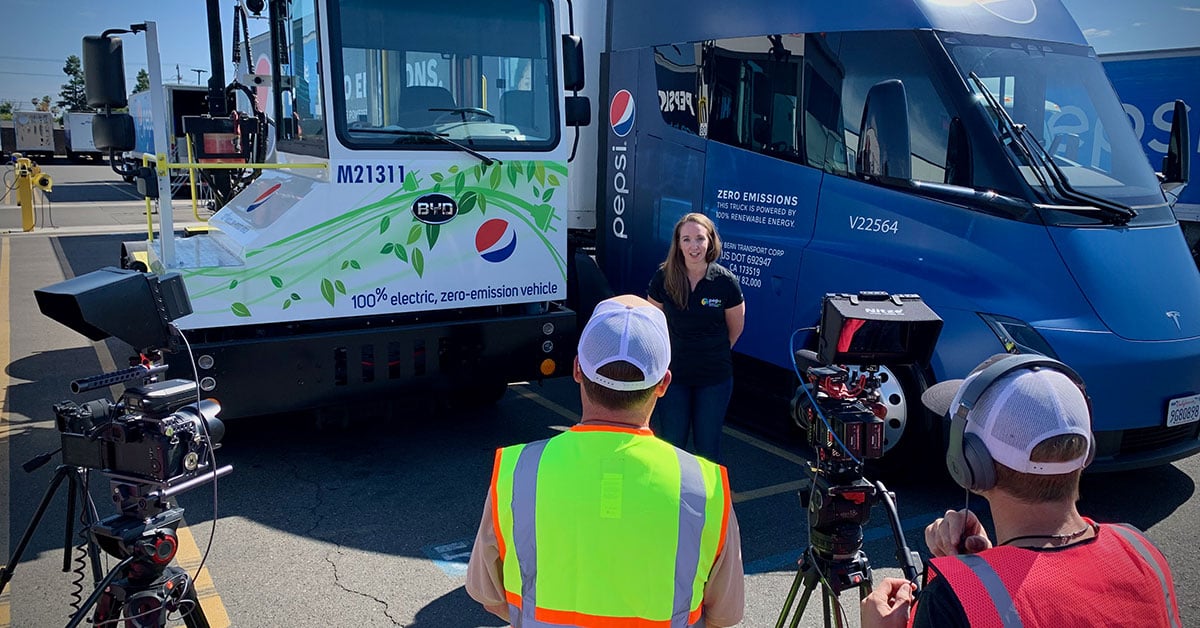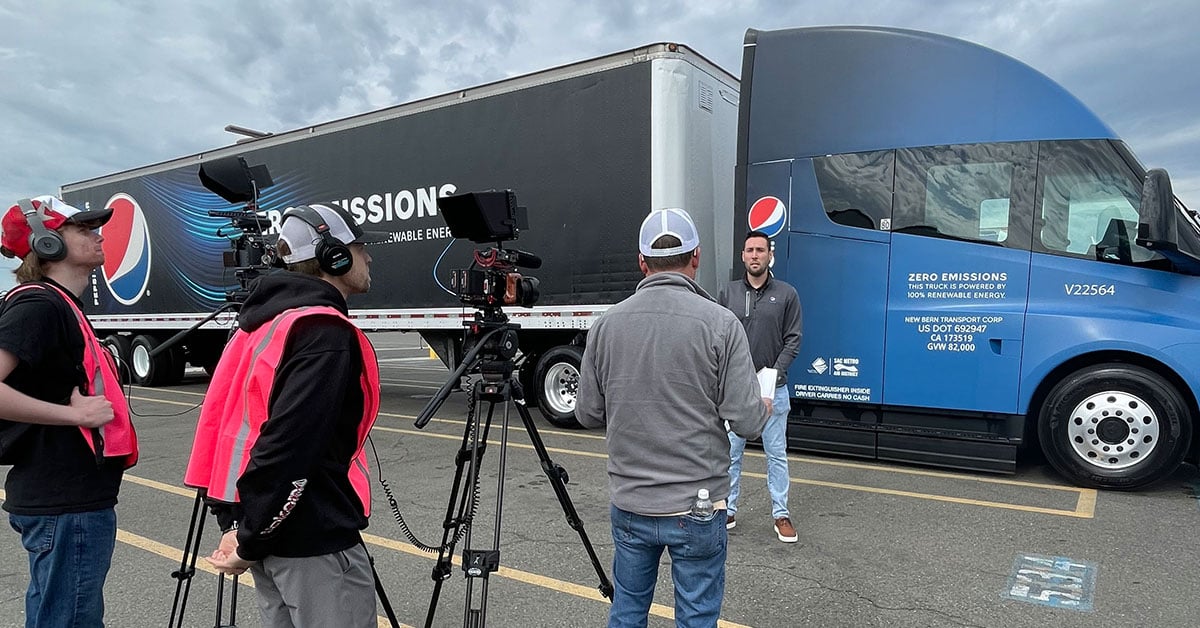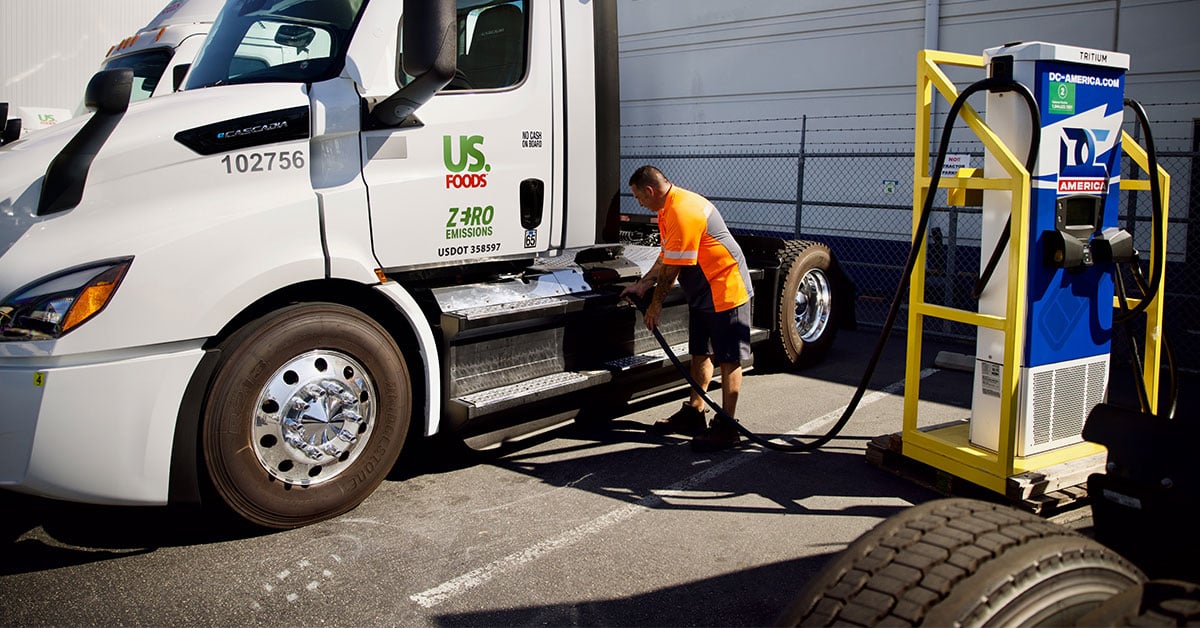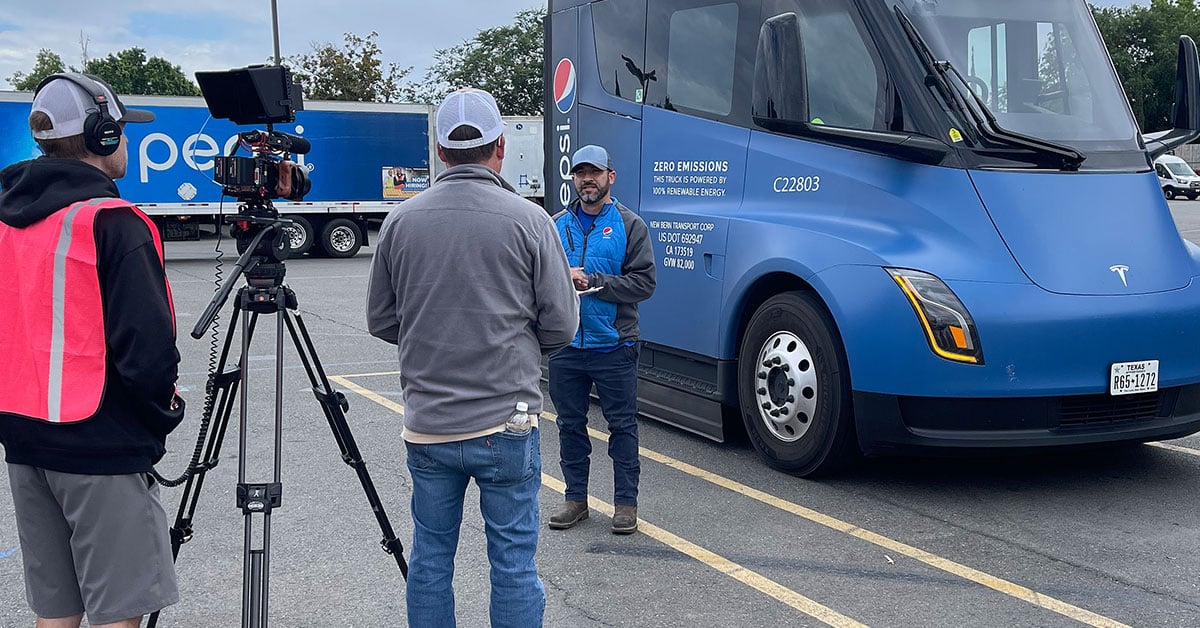What the Truck? Electric Vehicles Show Promise
by Women In Trucking Staff, on Apr 24, 2024 8:59:24 AM

Mike Roeth interviews Amanda Devoe, Transformation and Strategy Director, PepsiCo, with Tesla SEMI and BYD Terminal Tractor in background.
There’s a lot of buzz in the trucking industry about electric vehicles (EVs) – and several companies are actively trying to get the word out about the positive benefits of EVs. But this conversation is not without controversy. While companies with for-hire or private fleets deploying battery electric vehicles (BEVs) within fleets has been an uphill battle, the results of the North American Council for Freight Efficiency (NACFE) “Run On Less (ROL)” pilot late last year reveals that the road ahead may be evening out.
In particular, ROL participant PepsiCo observed some trucks in its fleet of Class 8 Tesla BEVs making the mountainous trek from Sacramento to Nevada and recovering their charge on their return, thanks to regenerative braking. PepsiCo is part of Frito-Lay North America, which is a Bronze Partner and Corporate member of the Women In Trucking Association (WIT).
PepsiCo’s fleet of Teslas demonstrated their ability to achieve high range with a fully-loaded tractor. The vehicles combined with 750KW charging stations that can restore bars to 95% from five or 10% in 20-30 minutes, shows the potential for beverage shippers performing regional deliveries with different shifts of drivers sharing trucks.

Mike Roeth interviews Dejan Antunovic, Electrification Program Manager, PepsiCo, with Tesla SEMI in background.
Amanda DeVoe, Director of Fleet Transformation and Strategy at PepsiCo said: “In addition to the benefit of regenerative breaking to extend charge, we have also gathered key learnings in the value of a high rate of charge to maintain business continuity and neutralize charging in slip seat, continuous transportation operations.”
Another ROL participant, OK Produce, which distributes produce throughout California, experienced a regenerative boost as well. Their Freightliner eCascadia semis ran 80- to 120-mile delivery routes through hilly terrain and returned to base with charges as high as 47%, according to OK Produce Director of Transportation, Bob Thomason in a recent ROL video.
OK Produce’s Orange EV yard tractors benefited from regenerative braking too—but from frequent starting and stopping. OK Produce’s experience in ROL showed regenerative breaking, the ease of onsite charging, and the reduction of diesel exhaust around the terminal make yard trucks an optimal duty cycle for BEVs.
According to Mike  , the Executive Director of NACFE, yard trucks are also a good choice for food shippers considering BEVs for the first time. “They’re a great place to start today because they’re easy to do, get into and start learning for fleets.” Roeth also led a conversation about EVs at Women In Trucking’s Accelerate! Conference & Expo last November in Dallas.
, the Executive Director of NACFE, yard trucks are also a good choice for food shippers considering BEVs for the first time. “They’re a great place to start today because they’re easy to do, get into and start learning for fleets.” Roeth also led a conversation about EVs at Women In Trucking’s Accelerate! Conference & Expo last November in Dallas.
Light trucks are another BEV application that shined in the ROL pilot, says Roeth.
Stop and start delivery routines and exhaust-producing terminal operations in urban environments have long been crying out for electrified fleets.
ROL participant Frito-Lay demonstrated the possibilities with their fleet of Ford E-Transit delivery vans.
Jordan Ratcliff, the Electrification Strategy Manager at Frito-Lay recently said: “Small format delivery vehicles are a solution that is ready to scale, particularly in urban and compact environments.
“Most routes are less than 40 miles per day at Frito-Lay’s Queens, NY distribution center. This duty cycle allows for highly scalable adoption and meaningful emissions reductions in areas that are often congested, noisy and face significant air quality challenges.”
Noise reduction is more than a nice-to-have for service-conscious shippers and their customers. In a ROL video, Tim Marten, the Southern California Area President of US Foods shares, “We have hospitality clients that love when electric vehicles pull up because it doesn’t wake up their guests.”

Portable Chargers are used at US Foods’ La Mirada, CA location and can be easily relocated to other facilities.
Additionally, Marten says clients value seeing zero-emission vehicles in the fleet more than ever. “We have large accounts that have their own GHG goals and our trucks contribute to their lower emissions.”
PepsiCo recently committed to cutting its GHG 75% by 2030. Like other shippers with ambitious ESG goals, they are looking to BEVs for answers today.
The results of the ROL program show viable options in regional heavy-duty trucks, yard trucks, and light-duty vehicles that are ready and waiting.
Roeth’s advice for companies holding off for the right time to invest in a BEV fleet is to get started now and learn about the field.
“Get your truck OEM and your charging people and your utility. Get those relationships together Because if you wait, you’re going to get run over with trying to do too much too fast later on.”

Mike Roeth interviews Hernesto Sandoval, Transport Driver, PepsiCo, with Tesla SEMI in background.
Benefits of Electric Trucks
Just a few short years ago, many in the industry thought that the idea of switching to an entirely electric semi-truck fleet sounded fantastical—but the future is here! Electric vehicle technology has advanced to the point that commercial electric trucks offer distinct advantages over diesel trucks, from reduced downtime to lower fuel costs. According to commercial truck manufacturers, the primary benefits to this new technology are sustainability, driver comfort, and lower maintenance costs (no engine oil changes, no transmission maintenance, no fuel filters, no turbos, no engine air filters).
However, one of the biggest obstacles in the way of mass adoption of EVs is a lack of truck charging infrastructure. Other concerns include the fact that EVs cost more (even with subsidies and incentives), they don’t travel as far on the road, and no one has yet to clearly defined the ROI of this technology.
While the future of EVs remains to be seen, the fact that the industry is exploring its potential underscores its potential.
Like this kind of content?
As a member of the Women In Trucking Association, stay on top of emerging trends and business issues impacting transportation and logistics; learn the importance of gender diversity in the workplace and the need for more women drivers; and see best practices in encouraging the employment of women in the trucking industry. Join today! Learn More






